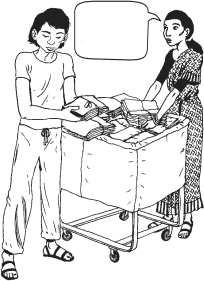Hesperian Health Guides
Helping Yourself and Helping Others
HealthWiki > Where Women Have No Doctor > Chapter 27: Mental Health > Helping Yourself and Helping Others
These suggestions are a few of the many ways a person can work toward better mental health. They will be most effective if you adapt them to your community’s culture and traditions.
Contents
Helping yourself
For some mental health problems, medicines may be helpful. Speak with a health worker who knows about medicines that treat mental health problems.
Women do not often find time in their busy days to do something for themselves. Notice how you are feeling and what activities or situations make you feel better. Simple things like spending time alone, cooking, gardening, or shopping with a friend can all be helpful.


Activities can let your feelings out. If you are angry, do some hard physical work. Making up poems, songs, and stories can be helpful when you have trouble saying things to others. You can write down your thoughts or draw a picture of your feelings without using words—you do not have to show these to anyone else.
Create pleasing surroundings. Try to fix your living space so that it feels right to you. No matter how small it is, you will feel more order and control when it is arranged the way you like. Try to have as much light and fresh air as possible.
Try to have some beauty around you. This could mean putting some flowers in the room, playing music, or going where there is a nice view.
 |
 |
 |
 |
Practicing these traditions regularly can help a person feel better and manage the stress in their life.
It is often easier to turn an existing group into a support group than to create a new one. Be careful when choosing helping relationships. Form relationships only with people who will respect your feelings and your privacy.

Helping relationships
It helps to have someone to talk to. In a helping relationship, 2 or more people make a commitment to get to know and understand each other. This can happen in any relationship— between friends, family members, or women who work together or already meet for another purpose. Or a new group may be formed among people who share a common problem. These are often called support groups.
Building a helping relationship
Even when 2 people know each other well, helping relationships can develop slowly because people often hesitate to share their problems. It takes time to get over these worries and begin to trust others. Here are some ways to build trust between people or among members of a group:
- Be open to hearing everything another person says without judging it.
- Try to understand how the other person feels. If you have had a similar experience, think about how you felt but avoid seeing someone else’s experience as exactly like your own. If you do not understand her, do not pretend that you do.
- Do not tell another person what to do. You can help her understand how the situation and pressures of her family, community, and work responsibilities affect her and her feelings, but she must make her own decisions.
No 2 people have exactly the same life experiences. There is always more to understand about another person.
- Never think of a woman as beyond help.
- Respect the woman’s privacy. Never tell others what she has told you unless it is necessary to protect her life. Always tell her if you plan to speak with someone else for her protection.
| Meeting together with others can help people: | |
|
 Sometimes we would arrive at the meeting in a bad way. No one wanted to speak. But a quick hug or one person smiling at another would make others do the same and everyone would begin to feel better. |
|
 Some of us had been sexually abused in the past but we had never been able to share it with others. It was only in the group that we could talk about these terrible things. |
|
 The group helped me to see others' points of view and to not get carried away by my feelings. This has helped me understand why other people react the way they do. |
|
 I often think poorly of myself and feel as if I am to blame for my family's situation. But it is not our fault that we are poor. Talking about this with others has helped me to understand why we women suffer the way we do. |
|
 There are things from our past that we have never discussed with our partners. In the group, we talked about how to deal better with these things. We get strength from each other. |
|
 We all decided to have a ceremony and then accompany one of our members to get a death certificate for her partner and arrange the title for her land. Doing this by herself would have been very difficult. |
Exercises for learning how to help
To help each other, members of a group need to understand what a helping relationship is and what makes it work. Try these exercises for:
These exercises are often done in groups but they can also be used by just 2 people.
- Sharing experiences of support. To become more aware of different ways to support others, the leader can ask members to tell a personal story in which they have received or given support. Examples might include accompanying someone, providing information, loaning money, or watching children. Then the leader asks questions like: What kind of support was it? How did it help? What are the similarities and differences among the stories? This discussion can help the group develop general ideas about what it means to support another person.
For example, tell a story of a woman whose husband drinks too much and beats her. The woman pretends nothing is wrong but speaks less and no longer participates in the community. Then the group can discuss: How could we as a group help her? How could she help herself? - Practicing active listening. In this exercise, the group divides into pairs. One partner talks about a topic for 5 to 10 minutes. The other partner listens without interrupting or saying anything except to encourage the speaker to say more. The listener shows she is listening by her attitude and by the way her body shows she is paying attention. Then the partners switch roles.
When the partners are finished, they think about how well it worked. They ask each other questions like: Did you feel listened to? What made it difficult to listen? Then the leader begins a general discussion about ways to best show listening and concern. You can discuss how listening can also include talking, such as asking questions, sharing experiences, or saying “Thank you for sharing that” or “I understand.” When you do not understand, ask the person to explain more.

Some women may feel more comfortable listening while sewing, weaving, or doing something else with their hands.
Exercises to support mental health and healing
Try some of these activities. Some help people feel better right away and others help prevent problems in the future.
More Information
working for change- Share experiences and feelings in the group. When stresses, fears, and problems weigh us down, we can also feel very alone. Just being able to talk about a problem can be helpful. After one person has told her story, people in the group can share similar experiences. When everyone has listened to these, the group can discuss what the stories have in common, whether the problem was partly caused by social conditions, and if so, what the group might do to change those conditions.
- Practice relaxing your body and mind. These exercises are particularly helpful for relieving stress. In a quiet place where everyone can sit down, someone leads the group to follow these steps:
- Close your eyes and imagine a safe, peaceful place where you would like to be. This might be on a mountain, by a lake or ocean, in a field, or some other place.
- Keep thinking about this place as you breathe deeply in through your nose and then out through your mouth. Do this for about 20 minutes. If it helps, think of a positive thought, such as “I am at peace” or “I am safe.”
- Learn to practice slow breathing.
- Breathe in through your nose and fill your lungs, counting as you breathe.
- Press your lips together softly, and breathe out through a small space between your lips, as if to whistle or blow out a candle. Count while you breathe out, and make it last longer than the breathing in.
- Create a story, drama, or painting. The group can make up a story about a situation similar to those experienced by members of the group. The leader starts the story and then another member continues to tell another part—and so on until everyone has contributed something and the story is complete. (The group can also act out the story as it is told or draw or paint a picture of the story.)

Use questions to help the group discuss the meaning of the story:
- What feelings or experiences are most important in this story?
- Why did these feelings occur?
- How is the person handling these feelings?
- What can she try doing to feel better?
- What can the community do to help?
If you tell a story about a problem, try to also talk as a group about ways to overcome the problem.
If a group has lived through a trauma and enough time has passed, they can analyze their own experiences rather than creating a story.
- Create a picture of your community. This exercise works best after the group has been meeting together for a while. The leader first asks the group to draw a picture of their community. (It is OK to draw a simple picture to get things started.) Then the group adds to the picture, drawing places where things happen that support mental health and places that may harm it. For example, where girls go to school might be drawn as a source of strength and self-esteem. A place where women are harassed or attacked could be drawn as a source of stress.
As the group adds to the picture, it can begin to discuss ways to improve the community’s role in mental health. The leader can ask questions like:- How can we strengthen those parts of the community that support our mental health?
- What changes can be made?
- How can the group help bring about these changes?
You can open your eyes if you need to at any time.

More Information
Organizing to Solve Community Health ProblemsIn El Salvador, a group of women from an urban squatters’ community decided to form a support group. They had lived through the civil war and now worked with victims of the war through their church. One member tells how the group began and how it has helped her:
“One day, many of us felt sad without knowing why. It wasn’t that anything had just happened, but many of us felt the same way. Then one of us realized that it was the anniversary of the day everyone fled our community because of the war. That was when we decided to form this group. We needed to feel close, to understand the things we had experienced, and to cope with how we felt about losing our sons, daughters, husbands, and neighbors to the war—and for what?
“In the group, we spoke of many experiences we had never been able to share with anyone else. This way, we slowly left behind the silence and the feelings of helplessness each of us had. We learned that fears become smaller when we can give them a name. We discovered that we all had the same fears: that others wouldn’t understand, that we would not find an answer, and that sharing memories out loud would make them even more painful.

“We spoke, cried, and laughed, but this time we did it together. The group supported us and helped us to change and to see new directions for our lives. We were able to bring new energy and strength to our work. Now we help victims of the war—not just to rebuild their homes and health, but also to overcome their fears and hopelessness. This way they can create a new future for themselves and for their community.
“Even though we all lost so much to the war—and peace has not delivered on its promises—we feel as though we have given birth to something new. And like a new baby, this group brings new spirit into the world and gives us the strength to go on.”
Helping women with reactions to trauma
Once a woman understands more about how and why she has certain reactions, the feelings usually have less control over her
- The most important way to support someone suffering from trauma is to help her learn to trust others again. Let her decide how fast your relationship develops. She needs to know you are willing to listen but that you will wait until she feels ready to talk. Doing everyday activities together may be best at first.

|
| Massage can help someone relax and let go of painful feelings. |
- It may help a woman to talk about her life before the trauma as well as what she is experiencing now. This may help her realize that although her life has changed a lot, in many ways she is the same person as before. If it seems right, encourage her to do some of the same.
- Some painful things may be too difficult for her to talk about or may be “buried” away where she cannot remember them. Exercises like drawing or painting or a physical activity like massage can help a person work through these painful feelings.
- If a woman has bad dreams about the trauma, she can put an object from her new life next to her as she sleeps. If she wakes suddenly, this will remind her she is in a different place now and safe.
- If reminders of the trauma make a woman react in fearful ways, help her make a plan to deal with those unexpected reminders. For example, a woman might tell herself, “His face is like the man who attacked me, but he is a different person and does not wish to hurt me.”
- If a person was tortured or raped, remind her that she was not responsible for what she said or did when that happened. Only those who tortured or raped her are to blame. Help her understand that one aim of torture is to make a person feel she can never feel whole again, but that this is not true.
What to do if someone wants to kill herself

|
| A woman who has made a plan for killing herself needs help right away. |
Anyone who has severe depression is at risk for suicide. You may notice changes, such as the person not taking care of herself, not acting like herself, or cutting off ties with people for no reason. A woman may not readily talk about thoughts of suicide but she will often admit them if asked. If she does, try to find out:
- Does she have a plan for how to kill herself?
- Does she have a way to carry out the plan? Is she planning to kill others as well (for example, her children)?
- Has she ever tried to harm or kill herself?
- Is her judgment affected by alcohol or drugs?
- Is she isolated from family or friends?
- Has she lost the desire to live?
- Is she going through a crisis or facing a desperate situation?

If the answer to any of these questions is “yes,” she is more likely to attempt suicide than other people. To help, first try talking with her. Some people may begin to feel better simply by telling you about their problems. If so, or if she still feels bad but is more in control of her feelings than before, ask her to promise that she will not hurt herself without talking to you first.
Asking someone if she wants to kill herself does not make her more likely to do so. It will help you know if her situation is urgent and allow her to talk about what she is feeling.
If talking about her problems does not help or if she cannot promise to talk to you, then she needs to be watched closely. Always tell the person considering suicide that you plan to talk with others to help protect her. Talk to her family and friends and encourage someone to be with her at all times. Ask them to remove dangerous objects from her surroundings.
If there are mental health services available, find out if someone can talk with her regularly. There may be a hotline number that people thinking about hurting themselves can use to speak or text with a trained counselor. Medicine for depression may also be helpful.



